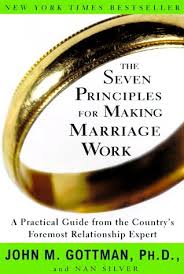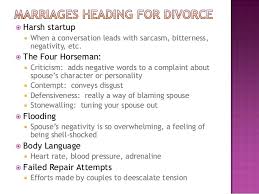
A Practical Guide from the Country’s Foremost Relationship Expert
This subtitle says it all: a make-love-last instruction book for the clueless — more than 50% of us, according to divorce statistics. This is a manual of marriage skills for people who weren’t exposed to them in the family of origin, featuring seven principal behaviors to espouse with our spouse and a set of exercises for each. How simple, yet how brilliant, and just like a textbook, only instead of calculus problems our homework is to trace helpful cognitive and emotional pathways in our neurons.
Principle 1: Enhance Your Love Maps
Who would’ve thought that something as obvious as cataloging our beloved’s inner life could save marriages. What is your significant other’s favorite salad dressing or dream car? What is his or her thinking on theological discrepancies? What kind of art, or music, appeals? If you don’t know the answer to these questions, you may not have cleared out enough cognitive space to make room for your partner. According to the Gottmans, “Without such a love map, you can’t really know your spouse. And if you don’t really know someone, how can you truly love them? No wonder the biblical term for sexual love is to ‘know.’ ”
Not sure what to ask? More than half the chapter contains questions and writing exercises to engage in with your partner. What better way to spend a Sunday afternoon than strengthening a bond by truly seeing the one we love.
Principle 2: Nurture Your Fondness and Admiration
Remember what attracted you to him or her, and keep that history alive in your mind by reliving your most joyous moments together. Remind yourself of your beloved’s good points, and update that log weekly as he or she displays those traits. Cherish is the word you’d use to describe the act of describing your loved one’s good traits. The Gottmans provide a list of adjectives and ask that you pick ten of them that apply to your spouse, and then write about it. Another exercise: pen a note about your partner’s good qualities and read it aloud to him or her during a romantic date. (That means you also must continue having dates with your partner. No slacking off because of familiarity; we know what that can breed.) This is based on research that practicing positive thoughts can bring huge benefits to the self and to partnerships. Aware that this might be easier said than done if the marriage is going through a rough spot, the Gottmans provide a detailed list of thoughts for you to write a few sentences about that can keep your outlook from sinking into the mud.

Principle 3: The famous Gottman “Turning Toward” instead of “Turning Away” or “Turning Against”
At first glance, this thinking seems too simple. According to this theory, a marriage’s success or failure is determined by spectacularly mundane moments such as when Spouse A says, “I think it’s going to rain” and Spouse B answers, “Let me check the forecast” instead of shrugging or altogether ignoring the bid for connection. The Gottmans say the quality of these routine interactions make or break a marriage because emotionally speaking, “turning toward” a partner who is bidding for connection amounts to an emotional deposit in the bank that will tide the marriage over rough spots. Gottman research shows that couples that stay together “turn towards” their partner 86% of the time, versus around 35% of the time for those who eventually divorce. The book provides many examples. Spouse A: “Look at that antique car!” Spouse B looks, grunts, says “Yeah.” (Turning Toward.) If Spouse B replies, “What do you know about antique cars,” that would be Turning Against. If Spouse B doesn’t bother to look, that would be Turning Away.
This section also includes pointers for dealing with bids for connection that are wrapped up in anger (“You’re answering emails now???” really means “Please come to bed with me so we can connect.”) Also discussed is the tendency of some people to “fix” their partner’s problems, when all the partner wants is to open up and bare the soul to the beloved, as well as one partner’s possible discomfort with the expression of fear and sadness by the beloved. As always, there are exercises to help you through your blocks.
Principle 4: Let Your Partner Influence You
Hey, guys, this one’s for you. “Statistically speaking, when a man is not willing to share power with his partner there is an 81 percent chance that his marriage self-destruct.” This principle is not about treating one’s partner with contempt and disrespect, because women can be equally guilty there. It’s about letting the spouse’s opinions and feelings influence their decision making, and women overwhelmingly do that, while too often, men do not return the favor. This finding was mocked (“Anything You Say, Dear”) on Saturday Night Live and by personalities as politically diverse as Rush Limbaugh and Bill Maher, which shows today’s sweeping cultural discomfort among men with the idea of giving women an equal voice. Men who allow themselves to be influenced by their wives also make better fathers, according to the Gottmans, because they have developed more emotional intelligence. These are the open-minded men who are able, on occasion, to yield. The tree that bends with the hurricane is the one that survives, not the one that stands rigid until it shatters, so don’t copy our Sexist-in-Chief if you want your relationship to last.
Principle 5: Solve your solvable problems
Problems come in two flavors, according to the book: Solvable and Perpetual. Essentially, perpetual problems are issues that will be present throughout the marriage, whereas solvable problems can be settled by a soft start-up, repair attempts, tolerance and compromise, and the avoidance of flooding.
The Gottmans say this fifth principle is simply about treating our spouse with the same good manners we display to the outside world. If a stranger trips on the sidewalk, we’re likely to ask if they’re okay, not criticize them for being a klutz.
Ladies, listen up. Women are more likely than men to bring up touchy issues, and if you want to solve the solvable problem, ditch the sledgehammer approach in favor of a “soft startup” that refrains from Criticism and Contempt, which are two of the Gottman Four Horsemen of the Apocalypse for relationships. Men: You need to be able to keep Defensiveness and Stonewalling (the remaining Horsemen) at bay.
A special note about in-laws: The Gottmans are unequivocal that both partners need to put their partnership first. The “we-ness” and solidarity of the couple must take precedence. Relatives may not like it, but they’ll eventually come around. A mother or a sibling will always be a mother or a sibling, but the partnership can dissolve if it is not honored.
Principle 6: Overcome Gridlock
Perpetual disagreements tend to be based in personality or lifestyle preferences. The way to avoid gridlock about them in the first place is to become skilled at the other six principles, and if this is the case then the perpetual problem becomes something like a pesky allergy that will never go away entirely but that is manageable. The idea is to discuss the issue without hurting each other, which triggers a downward spiral. These differences of perpetual problems often mean that we have dreams for our lives that aren’t being honored and that may even be hidden. For example, one person may want to go out often because during childhood staying at home was depressing, whereas the other partner may remember gatherings in front of the TV as the only time he or she was able to connect with parents who worked long hours. In this case, the TV may be a symbol for what makes that partner feel loved. Or, the stay-at-home partner may consider it wasteful to spend money going out because he or she has a dream of owning a mortgage-free home. Again, there are exercises to help us find the dreams within the conflict.
Principle 7: Create Shared Meaning
Couples should develop their own microculture, with shared customs, rituals and myths (Sunday dinner out? Champagne toast when one of you snags a new client? The How-We-Fell-In-Love story, “whether true, false, or embellished…”) Shared dreams are a part of this, but as the Gottmans explain in Principle 6, sometimes dreams are at variance between two people. Therefore, “a crucial goal of any marriage is to create an atmosphere that encourages each person to talk honestly about his or her convictions. The more you speak candidly and respectfully with each other, the more likely there is to be a blending of your sense of meaning.”
Pillars of Shared Meaning:
- Create a ritual (eating dinner together?) where you have time to connect and reinforce your togetherness.
- Support each other’s roles in the marriage by understanding your expectations of each other (equal partners, or provider husband and nurturer wife?)
- Shared goals, i.e. find the intersection of you and your spouse’s broader financial or charitable goals.
- Shared values and symbols, i.e. spiritual or charitable values.
Some last chapter findings: Couples who took the Gottman course AND whose marriages improved appeared to put an extra six hours a week into their marriage, and these hours included more care saying good-bye in the morning, greeting one another after work, kissing each other goodnight, a weekly date, and a weekly relationship overview. As the authors remind us, a happy marriage will do more for your health and longevity than just about anything else, so my conclusion is:
Buy this book, and do the exercises. It could make a huge difference in your life.
Almost every book I’ve reviewed for this site has opened my eyes to behavior I wish I’d known about earlier. Why doesn’t someone teach us this stuff in school? Imagine the difference it would make in the lives of the millions of children who watch in despair as their families shatter, when practicing these exercises might avoid that outcome.

Recent Comments